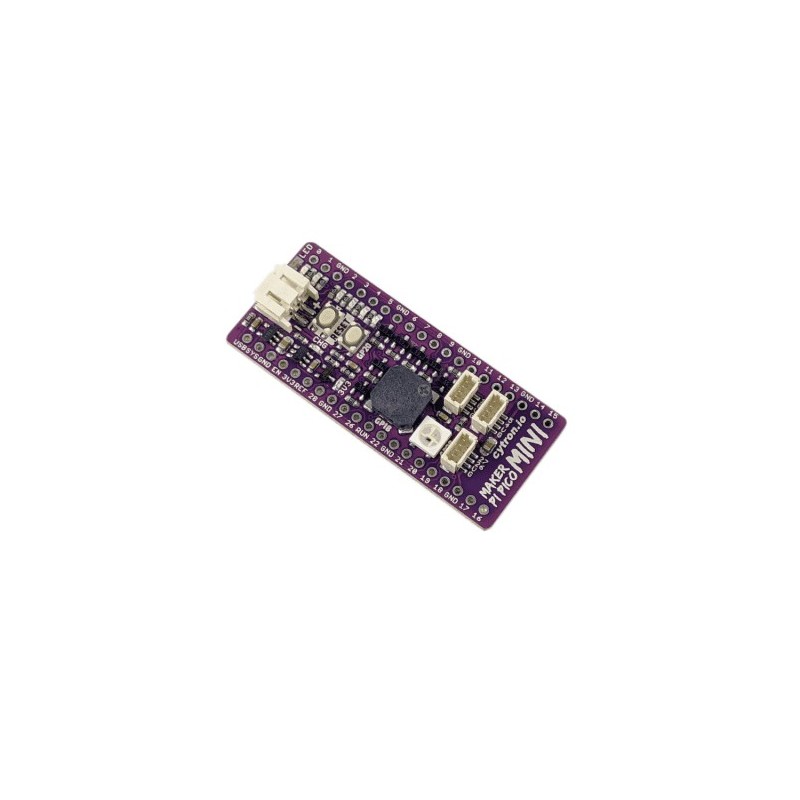

Base board with soldered Raspberry Pi Pico module. Equipped with two 20-pin connectors with LED diodes indicating the status of pins 0-5 GPIO and marked with pin names for easy connection of additional modules. The user also has an RGB NeoPixel diode, 3 Qwiic/Stemma QT sockets, a RESET button and a user button. In addition, the board has a buzzer and a LiPo charging circuit with a socket for connecting the battery.

The Raspberry Pi Pico W module is soldered on the bottom of the board. It is equipped with a system that has two ARM Cortex M0+ cores operating at a frequency of 133 MHz, 264 KB of RAM and 30 GPIO ports. The microcontroller itself is not equipped with flash memory, but on the board there is an external memory with a capacity of 2 MB connected via the QSPI interface. The platform supports the popular MicroPython and C/C++ programming languages.
Data sheet
Manufacturer BTC Korporacja sp. z o. o. Lwowska 5 05-120 Legionowo Poland sprzedaz@kamami.pl 22 767 36 20
Responsible person BTC Korporacja sp. z o. o. Lwowska 5 05-120 Legionowo Poland sprzedaz@kamami.pl 22 767 36 20
Base board designed for Raspberry Pi Pico. Equipped with numerous connectors, audio output, buzzer, micro SD slot, buttons and LEDs. Cytron MAKER-PI-PICO-NB
Base board designed for Raspberry Pi Pico. Equipped with numerous connectors, buzzer, buttons and LEDs. Cytron MAKER-PI-PICO-MINI-NB
Base board with soldered Raspberry Pi Pico W module. Equipped with numerous connectors, buzzer, buttons and LEDs. Cytron MAKER-PI-PICO-MINI-W
Universal board equipped with a metalized hole grid with a pitch of 2.54 mm, enabling mounting using goldpin strips or directly on the surface, with markings facilitating the identification of signals
An enhanced version of the Raspberry Pi Pico 2 with access to all 48 GPIO pins and an RP2350B microcontroller (Cortex-M33 or RISC-V) clocked at up to 150 MHz. It offers 16 MB of Flash, 8 MB of RAM, and a microSD card reader, making it ideal for complex embedded and IoT projects. With USB-C, Qwiic/Stemma Qt, UEXT connectors, and BOOT/RESET buttons, it offers high flexibility and easy integration with peripherals. Olimex RP2350-PICO2-XXL
Starter kit containing Raspberry Pi Pico, necessary connectors and a microUSB cable. The kit is recommended for people programming in MicroPython
No product available!
The RP2350-ETH development module combines the computing power of a dual-architecture microcontroller with Ethernet support, enabling the creation of compact and integrated network applications. Dedicated to projects utilizing TCP/IP transmission, it provides support for C/C++, MicroPython, and Arduino languages as well as a wide range of development resources. Thanks to its open architecture and compact form, it is suitable for IoT applications, communication gateways, and embedded systems requiring fast access to a local network.
Development board with RP2040 microcontroller. Equipped with a microBUS connector, it can work with Qwiic expansion boards. SprakFun DEV-18721
The board with the RP2040 microcontroller equipped with two ARM Cortex-M0 + cores operating at 133 MHz, 256 kB RAM. The board also has 16 MB of QSPI flash memory. The system can be programmed in C/C++ or microPython. SparkFun DEV-18288
Development board equipped with the Raspberry Pi Pico W module. It is an interesting alternative to Arduino Uno boards. It has a compatible shape and pin layout, while making available the large resources offered by the RP2040 microcontroller. Can be programmed with Arduino, MicroPython and CircuitPython. SB Components 26630
Compact development board based on the Raspberry Pi RP2350 microcontroller, equipped with two cores (ARM Cortex-M33 and Hazard3 RISC-V), 520KB RAM and 2MB Flash, ideal for IoT, smart home and wearable projects. With 11 IO pins, battery charging support, C/C++/MicroPython/Arduino programming and SMT support, it is perfect for rapid prototyping and mass production. DFRobot DFR1188
Base board with soldered Raspberry Pi Pico W module. Equipped with numerous connectors, buzzer, buttons and LEDs. Cytron MAKER-PI-PICO-MINI-W
Development board equipped with RP2040 microcontroller, RGB LED diodes, buzzer and Qwiic/STEMMA QT connectors. Pin spacing compatible with Arduino Nano. Cytron MAKER-NANO-RP2040
A board with an RP2040 microcontroller equipped with two ARM Cortex-M0+ cores that operate at a frequency of 133 MHz and 264 kB RAM. There is also 16 MB of QSPI Flash memory on the board. The system can be programmed in C/C++ or MicroPython. It offers a DVI connector, a micorSD card slot and a 40-pin GPIO connector. The module has a shape and connector arrangement similar to the popular Raspberry Pi Zero minicomputers. Waveshare RP2040-PiZero
NeoPixel 8-channel RGB LED driver. It features an RP2040 microcontroller with two ARM Cortex-M0+ cores, 264 kB of RAM and 8 MB of external Flash memory. Adafruit 5650
Versatile digital video module. It uses two RP2040 chips (one in the form of a Raspberry Pi Pico W board and the other as a separate RP2040 microcontroller) and is equipped with an HDMI output connector. Pimoroni PIM674
The board with the RP2040 microcontroller equipped with two ARM Cortex-M0+ cores, which work at a frequency of 133 MHz, 264 kB RAM. The board also has 2 MB of QSPI flash memory. The system can be programmed in C/C++ or MicroPython. Waveshare RP2040-LCD-0.96-M
The board with the RP2040 microcontroller, which provides a set of 2x20-pin connectors to which you can connect the HATs of the Raspberry Pi. SB Components 24032
RP2350-Touch-AMOLED-1.8 with battery is an advanced development board with an AMOLED display, touch support, motion sensors, audio, and a wide range of interfaces. Designed for mobile and embedded applications, it enables the creation of compact interactive devices with full open-source support.
RP2350-Touch-AMOLED-1.64-M is a compact board featuring the RP2350 microcontroller and an AMOLED display, equipped with touch input, motion sensors, and a full set of peripheral interfaces. Designed for modern mobile applications, HMI systems, and experiments with RISC-V and ARM architectures.

Base board with soldered Raspberry Pi Pico module. Equipped with numerous connectors, buzzer, buttons and LEDs. Cytron MAKER-PI-PICO-MINI
